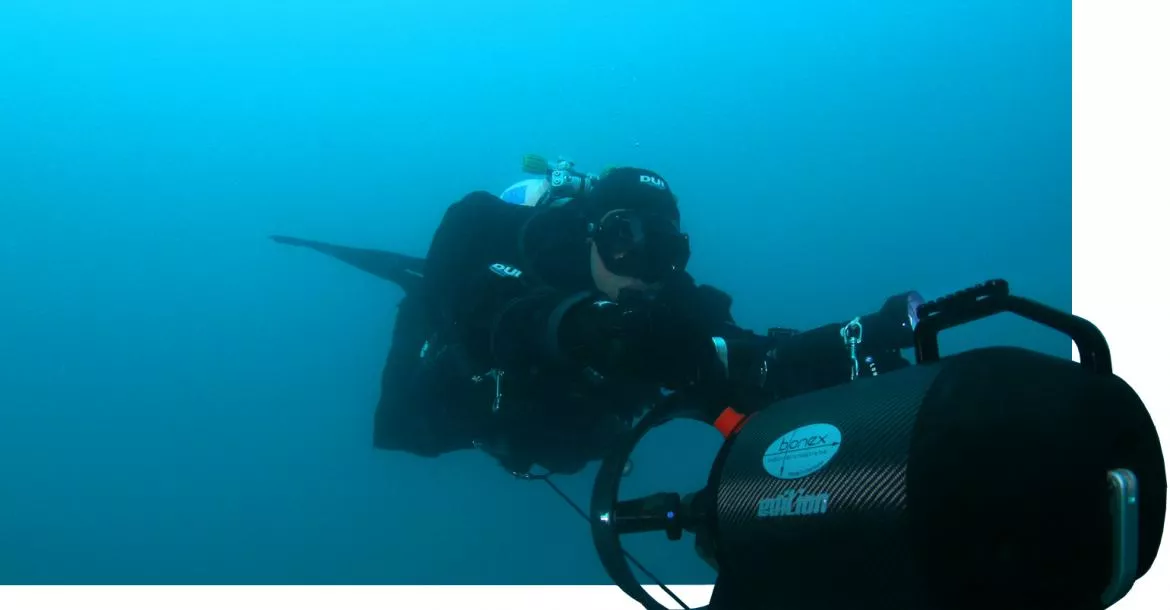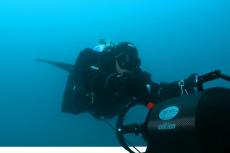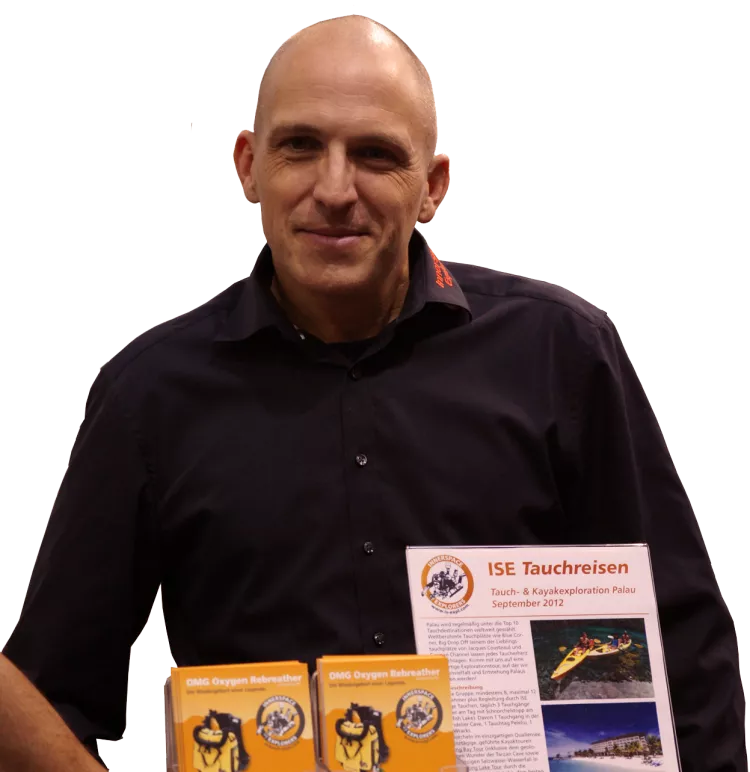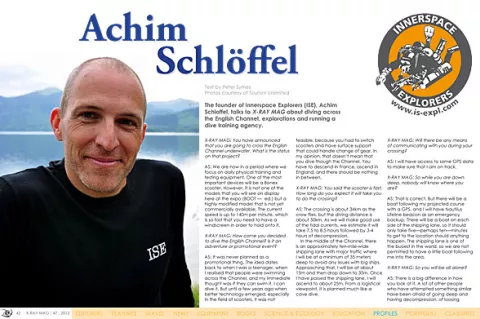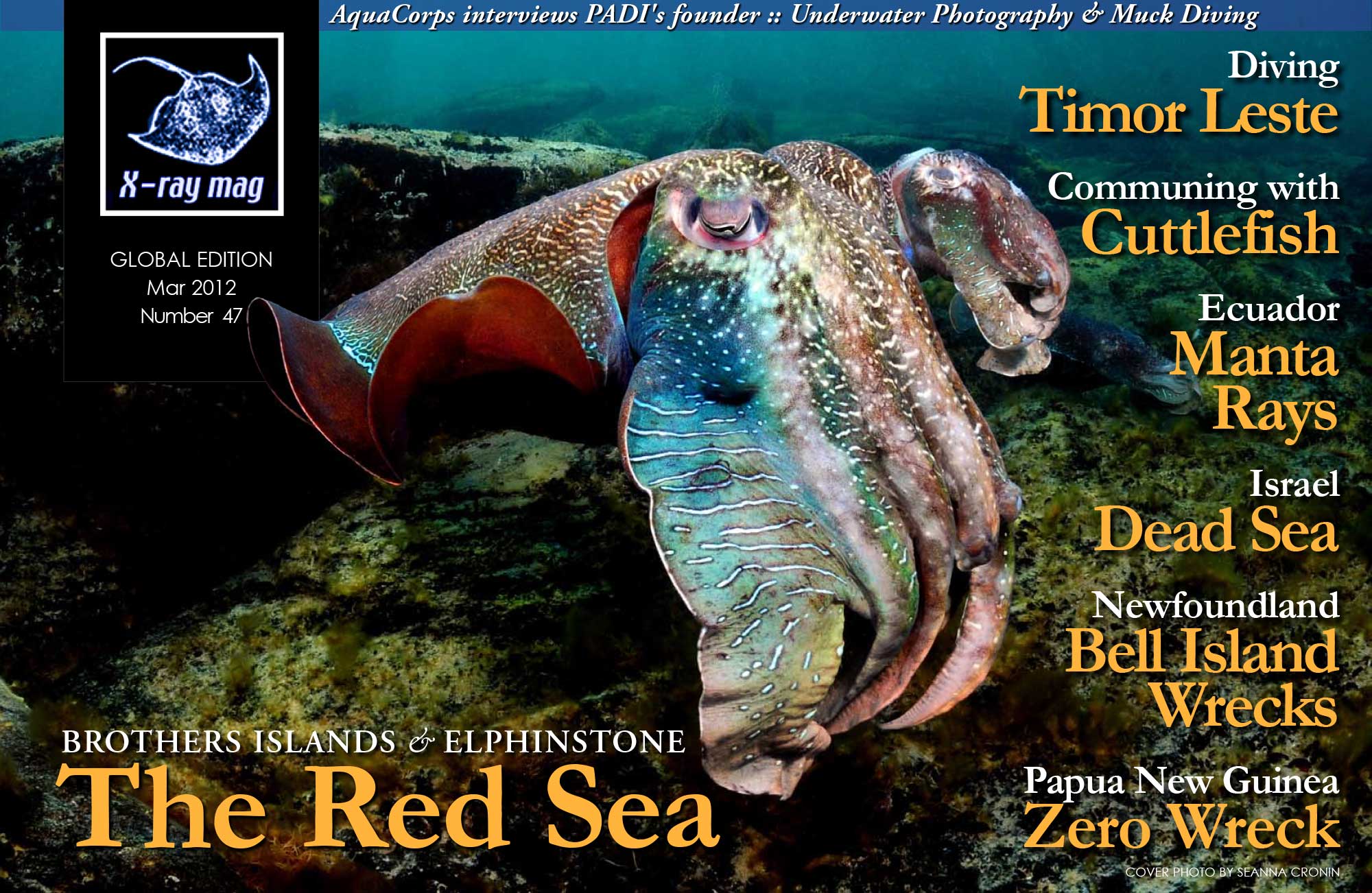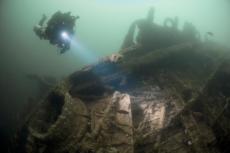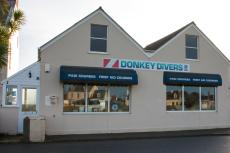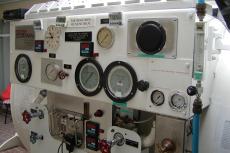The founder of Innerspace Explorers (ISE), Achim Schloffel, talks to X-RAY MAG about diving across the English Channel, explorations and running a dive training agency.
Contributed by
X-RAY MAG: You have announced that you are going to cross the English Channel underwater. What is the status on that project?
AS: We are now in a period where we focus on daily physical training and testing equipment. One of the most important devices will be a Bonex scooter. However, it is not one of the models that you will see on display here at the expo (BOOT — ed.) but a highly modified model that is not yet commercially available. The current speed is up to 140m per minute, which is so fast that you need to have a windscreen in order to hold onto it.
X-RAY MAG: How come you decided to dive the English Channel? Is it an adventure or promotional event?
AS: It was never planned as a promotional thing. The idea dates back to when I was a teenager, when I realised that people were swimming across the Channel, and my immediate thought was if they can swim it, I can dive it. But until a few years ago when better technology emerged, especially in the field of scooters, it was not feasible, because you had to switch scooters and have surface support that could handle change of gear. In my opinion, that doesn’t mean that you dive though the Channel. You have to descend in France, ascend in England, and there should be nothing in between.
X-RAY MAG: You said the scooter is fast. How long do you expect it will take you to do the crossing?
AS: The crossing is about 34km as the crow flies, but the diving distance is about 50km. As we will make good use of the tidal currents, we estimate it will take 7.5 to 8.5 hours followed by 3-4 hours of decompression.
In the middle of the Channel, there is an approximately ten-mile-wide shipping lane with major traffic where I will be at a minimum of 35 meters deep to avoid any issues with big ships. Approaching that, I will be at about 15m and then drop down to 35m. Once I have passed the shipping lane, I will ascend to about 25m. From a logistical viewpoint, it is planned much like a cave dive.
X-RAY MAG: Will there be any means of communicating with you during your crossing?
AS: I will have access to some GPS data to make sure that I am on track.
X-RAY MAG: So while you are down deep, nobody will know where you are?
AS: That is correct. But there will be a boat following my projected course with a GPS, and I will have Nautilus Lifeline beacon as an emergency backup. There will be a boat on each side of the shipping lane, so it should only take five—perhaps ten—minutes to get to the location should anything happen. The shipping lane is one of the busiest in the world, so we are not permitted to have a little boat following me into the area.
X-RAY MAG: So you will be all alone?
AS:There is a big difference in how you look at it. A lot of other people who have attempted something similar have been afraid of going deep and having decompression, of loosing contact with the surface and what not, and that made all the difference because then you are exposed to tides and wind, which made it hard for them. But if you consider it like a cave dive, you take most of these problems out of the equation. The idea of being alone in the dark is not an issue because, as a cave diver, you are used to it. We do that all the time. It is more about the configuration.
X-RAY MAG: Is there any scientific aspect or research involved?
AS: We are in negotiation with both Aquamat and DAN regarding the collection of data, but since we are only doing one dive, which is not going to be repeated, it can hardly be called scientific. We will collect a range of physical data, but it is more about the technical data.
Bonex is interesting in the performance of their scooters, and I will bring along some computers to test their performance during long exposures and see how they correlate to our calculations.
X-RAY MAG:Do you have any way of determining what the current will be at depth? It may be different from that on the surface.
AS: We have a pretty good understanding of the water flow and what goes on and when. Once again, it is one of the busiest shipping lanes in the world, so we have a pretty good idea of the currents.
I would also like to mention that the WDCS—The Whale and Dolphin Conservation Society—has shown considerable interest in the outcome. While there are not many marine mammals in the channel—they seem to be located up farther north—the organization would like to have a first witness account about what the environment is like when you are surrounded by big vessels in terms of noise and other disturbances.
X-RAY MAG: I understand that you also head a training agency. What is the difference between yours and all the others?
AS: First of all, we have a couple of unique points in the training program. For example, certifications are limited to three years, after which you have to renew, and you cannot do that by email. You have to meet with an instructor and prove to him or her that you are still capable and possess the skills for which you are certified. Especially in technical diving, that is important. It is no good when somebody who is trimix certified and hasn’t been diving for perhaps ten years just jumps into the water, endangering himself and those who are diving with him. The same principle applies to instructors. They also have to renew every three years and prove to us that they are still able to teach at the required levels.
Secondly, we emphasise critical skills. We strongly believe that technical diving training should be tough. We want the student to figure out during training whether he or she is mentally and physically capable and able to handle the stresses involved. We do not want them to figure that out at a depth of 80m but in three meters, with an instructor beside them.
X-RAY MAG: So, are you saying that your courses are also some kind of stress test?
Yes, absolutely. When you are purposely put under a lot of stress, you will learn how to handle this. During training, we will give you experiences in all the potential problems you could face in a real dive. For example, if I clap you on your shoulder to signal that we are pretending that your regulator is not working anymore, what is the experience worth if you are still breathing from it? What is the point?
However, if I make you switch on a dead regulator, you will have the experience that it is not working, that you cannot breathe from it and you have to figure out what to do. Perhaps you will reach back and switch it on rather than reach out for your buddy or race to the surface. If we do this three times, and you freak out every time, we will be obligated to tell you that this is not for you.
The major structural difference between our organisation and the others is that we firmly believe in exploration. It may be a somewhat overused term, but who is really exploring? But if somebody invests all the time and money required to become a technical diver, it means that he or she has some dreams of seeing a virgin wreck or exploring a cave passage where nobody has been before. But if you look at the state of the industry in the past ten years, it has usually meant ending up in the same quarry as before but with three stages more, and in turn, that means that divers lose interest, and they quit, which is a shame.
So, I think that the organisation also has a duty to make sure that these divers are also able to participate in the type of diving that they are trained for. So, Inner Space Explorers are also involved in setting up all kinds of projects and trips on a regular basis in collaboration with partners and centres all over the world. And then we make our students participate in these expeditions.
X-RAY MAG: So, your philosophy is that technical diving is more means to this end—a way of making exploration possible?
AS: It is a tool, yes. For example, we had this course in Denmark, and in the area, there were two wrecks in only five meters of water. Everybody knew where they were, and the local PADI centers used them for their navigation training. But when I asked around what the wrecks were and for how long they had been there, nobody knew. So there was the project: figure it out.
We then spent a week doing measurements and a photo-mosaic, and in the end, we learnt that the wrecks were of two vessels that had collided. We also did some carbon dating and found out that they must have gone down around 1640, and suddenly there was a lot of interest. A university then became interested in the matter, and all of a sudden, it became a big project.
Another project that we have coming up is the Dive and Kayak Expedition in Palau, where you do not have to be a technical diver, though there is a going to be a cave and wreck dive. It is going to be a small group led by me, but the whole idea is to follow the ecosystems from the inner lagoon where we can see fish nurseries to the outer reefs, so you get a better understanding of the unique corals and geology of Palau. This is a good example of exploration that doesn’t require any advanced or technical diving but is something everyone can enjoy.
There is no trimix or deco involved, but we go into fine tuning of skills and trimming that we promote and teach. These ecosystems are delicate, so it is essential that divers are properly trimmed so that they do not disturb the environment. It makes a big difference. In is regard, I should emphasise that some of the courses, such as Basics of Exploration, is open to everyone, and it doesn’t require any technical equipment or training.
During the course, which will focus on buoyancy skills, there will also be some exposure towards different types of equipment and configurations, so you will understand what happens if you change your gear into a more technical direction. The first entry course is for anyone who wants to have better skills underwater and not be reliant on a buddy. It is also great for photographers.
X-RAY MAG: You say entry level, but it is not a basic scuba diving course?
AS: No. You have to be a certified diver. It is more akin and comparable to GUE’s Fundamentals but has a more practical approach and is focused on skill refinement. In fact, we accept the Fundamentals course as an entry requirement for the subsequent classes.
X-RAY MAG: Is there any minimum requirement to join these courses?
AS:On our last course, we had divers ranging from Open Water divers to Trimix Instructor Trainers, and the funny thing was that in the end, they all said that they learned a lot. So, it’s about filling the gaps in the existing training.
X-RAY MAG: How long does such a class take?
AS:It is a 3½- to 4½-day course. The extended course takes a day more because it includes Tri-ox—hyperoxic trimix but on a no-decompression recreational level—so you can take a single tank and stay at a 36m depth and still get the benefits of the 70 percent nitrox and the 30 percent helium.
X-RAY MAG: So divers can come in with an entry level course, and you will let them do mixed gases in the end?
AS:Sure. No problem. It is a wrong assumption that just having a different mix of gases in your tank makes it dangerous. It is not. The question is where and how do one use that mix. Tri-ox can be beneficial in 20 meters if one is taking pictures of fish. I often take pictures at such depths, and when I compare the images taken on nitrox or trimix, I can see a difference. It is just about being more aware.
X-RAY MAG:Being a Devil’s advocate, I ask you why do we need yet another agency to do all this?
AS: Because we offer something that is not on the market.
X-RAY MAG: Couldn’t these courses be offered from within some of the existing agencies?
AS: I did. I worked for ten years in GUE, and I think when we started, we were pretty much where we are now—except perhaps for the exploration part of it— and people really appreciated it. But then, it just took a different path—one could say more commercial—and I didn’t want to follow that road. The growing number of students choosing InnerSpace Explorers for their training proves me right in that people want this kind of harsh kind of training and that they appreciate being a real part of a team.
We also offer courses in a proper context. It is like when you had your drivers licence for ten years and your driving school came back to you and offered you a course in driving in icy conditions. But if you live in Dubai, what is the use of that? In InnerSpace Explorers, we will also actually take you to Norway, for example, where you will get a real opportunity to use your skills. That is another significant difference.
X-RAY MAG:How big is Inner Space Explorers?
AS: We are in our fourth year. We have about 600 certified divers and 18 instructors. We keep growing but slowly. I get a lot of requests from instructors, but out of some 10-15 requests about instructorships, there is probably just one I would seriously consider. It’s because they would be representing my name. I have over the years trained more than 3,000 divers, and they are all healthy and in good spirits, and I want to keep it like that.
X-RAY MAG: Where do the majority of your students come from? Germany?
AS: No, from all over the world, but mostly Europe and the Middle East have been growing fast recently.
X-RAY MAG: If you are concerned about instructors not representing you properly, does that mean that you have to train each one personally?
AS: I have trained them all up to now. I have been quite concerned about what goes on when you inject all these intermediary layers with instructor trainers and instructor trainer trainers that you see in bigger organisations because, all of sudden, you completely lose overview and control of what is going on. So right now, we are considering just having one instructor trainer for each region, i.e. one for the Middle East, one for Europe and one for the United States.
Right now, the instructor candidate needs to obtain two signatures from the board of directors, which consists of five members. One instructor trainer and one from headquarters cannot certify an instructor on their own. This is to avoid having friends and such being appointed instructors without the necessary qualifications. At least two from HQ need to sign off on the candidate. So, either there is a second director on location during the Instructor Training Course (ITC) or the candidate has to see one of them at another meeting. This assures the quality that we aim for in instructor training, and it prevents “mass production”.
X-RAY MAG: Aside from diving the English Channel, do you have any other grand projects in the pipeline?
AS: There are lots of places I personally would like to see—Bikini atoll, some deep stuff off Palau and various wrecks around the world, but coming up soon are some new wrecks and some caves off Sardinia we want to explore. We will be quite busy the next two to three years just with these plans.
X-RAY MAG: Do you have any role models?
AS:When I was seven, I was asked what I wanted with my life, and I replied that I wanted to be like Jacques Yves-Cousteau, and (giggles) it is funny that we are now not far off in terms of diving and exploration.
X-RAY MAG: What about teaching philosophy?
AS: We are a DIR-minded training agency, and we stand for tough training but fair training. We will tell you if technical diving is not for you. ■

